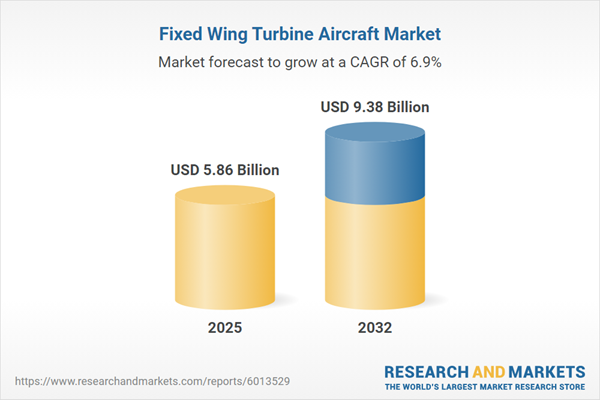Speak directly to the analyst to clarify any post sales queries you may have.
The fixed wing turbine aircraft market is undergoing significant transformation as advances in technology and changing regulatory requirements reshape global fleet strategies, design paradigms, and supply chain frameworks.
Market Snapshot: Fixed Wing Turbine Aircraft Market Growth and Dynamics
The fixed wing turbine aircraft market grew from USD 5.48 billion in 2024 to USD 5.86 billion in 2025. It is projected to expand at a CAGR of 6.94%, reaching USD 9.38 billion by 2032. Robust demand across both commercial and defense aviation, combined with ongoing infrastructure development and the adoption of advanced propulsion systems, is driving significant opportunities for industry stakeholders. This market is characterized by the integration of digital maintenance technologies, sustainability initiatives, and adaptive supply chain responses to geopolitical and regulatory developments.
Scope & Segmentation of the Fixed Wing Turbine Aircraft Market
This report comprehensively analyzes current trends and opportunities across the fixed wing turbine aircraft landscape, highlighting segmentation and technological adoption:
- Aircraft Types: Business jets (heavy, light, midsize, ultra long-range), freighters (converted, purpose built), narrow body jets (freighter, passenger), regional jets (71 to 100 seats, up to 70 seats), wide body jets (freighter, passenger).
- Engine Types: Turbofan (high and low bypass ratio), turbojet, turboprop (above 2,000 shp, up to 2,000 shp).
- Applications: Business (charter, corporate, fractional), commercial (low cost carriers, major and regional airlines), military (fighter, surveillance, tanker, trainer, transport).
- Range Categories: Long range, medium range, short range, ultra long range.
- Seating Capacities: 101 to 200 seats, 20 to 100 seats, above 200 seats, up to 19 seats.
- End Users: Airlines, government (civil, defense), and private operators (charter, corporate).
- Regions: Americas (North America, Latin America), Europe, Middle East & Africa, Asia-Pacific (including major countries and hubs in each region).
- Leading Companies: Airbus SE, The Boeing Company, Textron Aviation Inc., Embraer S.A., Bombardier Inc., ATR GIE, Dassault Aviation SA, Gulfstream Aerospace Corporation, Mitsubishi Aircraft Corporation, Pilatus Aircraft Ltd.
- Key Technologies: Digital twin platforms, predictive maintenance, sustainable aviation fuels, advanced materials, and AI-enabled cockpit systems.
Key Takeaways for Senior Decision-Makers
- Technological upgrades in propulsion and digital maintenance are reshaping cost and operational efficiency models across the fixed wing turbine aircraft sector.
- Sustainable technologies, including alternative fuels and hybrid-electric propulsion, are moving from prototype to adoption, prompting supply chain realignment and new investment priorities.
- Geopolitical events and evolving trade policies require adaptive sourcing strategies, partnership diversification, and increased transparency throughout the supply chain.
- Data-driven decision-making and modular design philosophies are enabling accelerated product development and service-differentiation strategies.
- Regional market dynamics, such as infrastructure investments in Asia-Pacific or regulatory drivers in EMEA, are guiding strategic fleet and MRO decisions for both incumbents and new entrants.
Tariff Impact on the Fixed Wing Turbine Aircraft Market
Recent implementation of United States tariffs has triggered significant shifts in the global fixed wing turbine aircraft supply chain. Many manufacturers and suppliers are localizing production, diversifying component sources, and reworking procurement strategies to sustain resilience. Aircraft operators, meanwhile, are revising acquisition timelines and embracing refurbished component markets in response to cost and availability pressures. These actions have heightened the focus on supply chain transparency and tariff risk management, shaping procurement strategies amid evolving global trade patterns.
Methodology & Data Sources
This report employs a multi-dimensional research methodology, including primary interviews with senior aerospace leaders and technical experts. Peer-reviewed industry reports, regulatory filings, and technical publications form the backbone of the secondary data set. All findings are validated through data triangulation and scenario analysis to ensure reliability and actionable insight.
Why This Report Matters
- Enables strategic planning with actionable segmentation and regional perspectives tailored for senior executives.
- Highlights the impact of technological and regulatory shifts, empowering informed investment and partnership decisions.
- Supports risk management through detailed analysis of tariff exposure and supply chain vulnerability.
Conclusion
The fixed wing turbine aircraft market is poised for transformative growth, guided by innovation, regulation, and evolving global needs. Organizations that prioritize adaptability and data-driven strategies will be best positioned for long-term success.
Additional Product Information:
- Purchase of this report includes 1 year online access with quarterly updates.
- This report can be updated on request. Please contact our Customer Experience team using the Ask a Question widget on our website.
Table of Contents
3. Executive Summary
4. Market Overview
7. Cumulative Impact of Artificial Intelligence 2025
Companies Mentioned
The companies profiled in this Fixed Wing Turbine Aircraft market report include:- Airbus SE
- The Boeing Company
- Textron Aviation Inc.
- Embraer S.A.
- Bombardier Inc.
- ATR GIE
- Dassault Aviation SA
- Gulfstream Aerospace Corporation
- Mitsubishi Aircraft Corporation
- Pilatus Aircraft Ltd.
Table Information
| Report Attribute | Details |
|---|---|
| No. of Pages | 182 |
| Published | November 2025 |
| Forecast Period | 2025 - 2032 |
| Estimated Market Value ( USD | $ 5.86 Billion |
| Forecasted Market Value ( USD | $ 9.38 Billion |
| Compound Annual Growth Rate | 6.9% |
| Regions Covered | Global |
| No. of Companies Mentioned | 11 |









